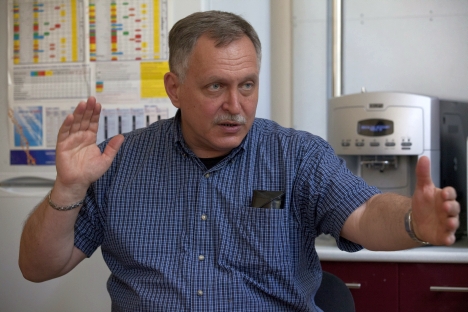
Russian stem-cell researcher Konstantin Agladze: "We created cardiac tissue to test medications. Such models are in great demand among pharmaceutical companies, which create new products." Source: Rossiyskaya Gazeta
In about 20 years, doctors will be able to replace human body parts the way mechanics change car parts in a repair shop. Patients will no longer need donors or mechanical implants, because all organs will be grown in test tubes. World-renowned Russian scientist Konstantin Agladze tells Ogonyok about his work in this field.
The world is getting used to regular news reports from the world of stem-cell medicine. Weekly – if not daily – sensational stories surface about yet another improbable test with cells. Still, most people realize that these are isolated incidents, and that this kind of technology will not be part of everyday medicine any time soon, if at all.
These tests use stromal cells taken from human embryos. Such cells can turn into whatever scientists need them to be – heart tissue, bones, liver or skin (there are more than 200 various types of tissue in our body). However, further use of these cells runs into very serious ethical and moral difficulties.
The situation changed about five years ago, thanks to Japanese researcher Shinya Yamanaka. Now, the patients themselves can act as the donor of stem cells for engineering organs – ethical problems and biocompatibility issues will be a thing of the past. Biologists took a few years to ponder the idea, and then it was time for breakthroughs.
Russian researcher Konstantin Agladze carried out the most promising test, managing to grow in vitro cardiac tissue together with Japanese scientists at Kyoto University.
Ogonyok: The world media first wrote that you had created an in vitro artificial heart, but then their comments became more cautions. Tell us about what you really did.
Konstantin Agladze: We are talking about cardiac engineering here. We didn’t just manage to artificially engineer working cardiac tissue from induced pluripotent stem cells, where, previously, only isolated cells had been grown in small clusters. We have also developed a technology to create structured cardiac tissue using a 3-D frame made from special polymeric nanofibers. We use this frame to not only engineer cardiac cells, but also form healthy cardiac tissue.
Ogonyok: Can you build a heart using this tissue?
K.A.: Theoretically you can, but we created our tissue to test medications. Such models are in great demand among pharmaceutical companies, which create new products. They currently skip the tissue test phase and test their medications on animals. But animals have quite different cardiac cells compared to humans. Our research fills this niche and will help make medications more effective and better targeted, thus saving money.
Another challenge is to reprogram the patient’s own cells – for instance, epithelium cells, to grow cardiac cells (cardiomyocytes) – in order to engineer an implant that is compatible with the patient’s body. These are so-called cardiac patches – one of the most actively developed research areas for regenerative biomedicine.
Such patches are supposed to be stitched to damaged heart tissues. It should be noted that cardiac tissue is a special type of muscular tissue. Therefore, we need to not only reprogram cells, but also achieve the right tissue structure.
Polymeric nanofibers made from biocompatible materials were the solution. These nanofibers help us build cells according to our architecture.
Ogonyok: You make use of polymers when producing patches. Can these materials have any side effects?
K.A.: Because our method is based on using the patient’s own pluripotent cells, we automatically deal with the problem of immune barriers. As for the nanofibers that form the frame of the patch, they are biodegradable materials, which completely dissolve in blood when the patient is treated and recovers.
Ogonyok: Can you use this technology to build other organs – say, a liver?
K.A.: It can be applied in lots of areas, but we’re talking about the distant future here.
Ogonyok: How much time did you spend developing this method in the Kyoto lab?
K.A.: More than three years. We developed this technology from scratch and are now taking it to Russia.
We will not only share our knowledge, but also promote research together with the Kyoto lab. The main scientific objective that our science and education center at the Moscow Institute of Physics and Technology has to address is the search for ways to control the physiology of cells. We have developed the most advanced methods to treat and prevent the most dangerous cardiac arrhythmias. My lab in Kyoto University in Japan is working on the same task.
Ogonyok: The Moscow lab was established almost a year ago. What results do you have so far?
K.A.: The lab is up and running, but, in order to have the same results that we have in Japan, we need to put much more effort into it. I hope that the situation will improve. We already have a lab, and my students in Russia are very competent professionals.
The interview is first published in Russian in Ogoniok magazine.
All rights reserved by Rossiyskaya Gazeta.
Subscribe
to our newsletter!
Get the week's best stories straight to your inbox